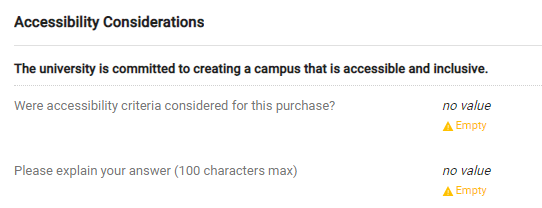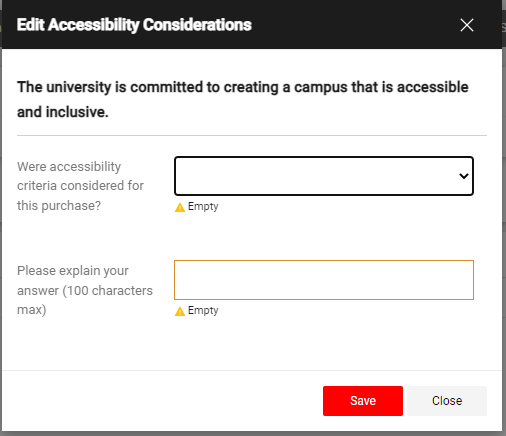- Step 1: Add your Item(s) to your eShop Cart
- Step 2: Locate the Accessibility Considerations Questions
- Step 3: Answer the Accessibility Considerations Questions
Carleton University is committed to creating a campus that is accessible and inclusive. That means reducing the barriers to participation as much as possible. Beginning May 1, 2023, in conjunction with our shared responsibility under AODA, some changes will be made to financial transactions (eShop Purchase Requisitions, Cheque Requisitions, Pcard, and Internal Purchase Requisitions). This section will guide you through these changes and how to fill out the new accessibility questions set you will see when checking out.
Step 1: Add your Item(s) to your eShop Cart
Complete the first step of your purchase as usual by adding item(s) to your cart (but start thinking about accessibility now!).
Step 2: Locate the Accessibility Considerations Questions
Continue to checkout. The “Accessibility Considerations” questions are located below the “Expense Funding” header and look like this:

Step 3: Answer the Accessibility Considerations Questions
Once you have located the accessibility questions, click on the pencil icon in the top right corner to bring up the box below:

Question: “Were accessibility criteria considered for this purchase?”
Choose from the following options:
- Yes, accessibility was considered for this purchase.
- No, accessibility was not considered for this purchase (please explain why below).
- I do not believe accessibility needs to be considered for this purchase
If you answer, “No, accessibility was not considered for this purchase”, explain why in the space provided.
HINT: Even when products or services appear not to require the consideration of accessibility, think about how you communicate with the vendor. Vendors offering multiple methods of communication (phone, fax, email, chat, text-to-speech-enabled websites, etc.) for customer service and support is an accessibility consideration that can be documented. Remember, our goal is to reduce barriers of all kinds, and accessible communication methods help us reach that goal.
